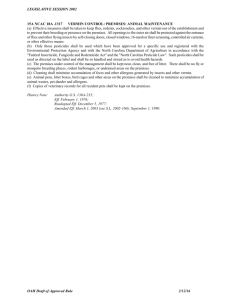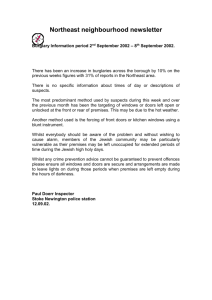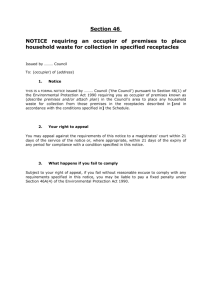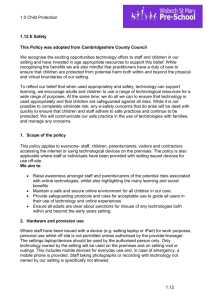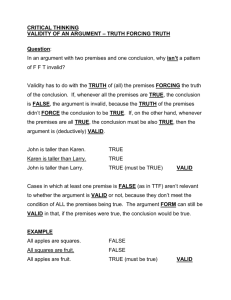Fire Safety Risk Assessment EXAMPLE Small Licensed Premises
advertisement
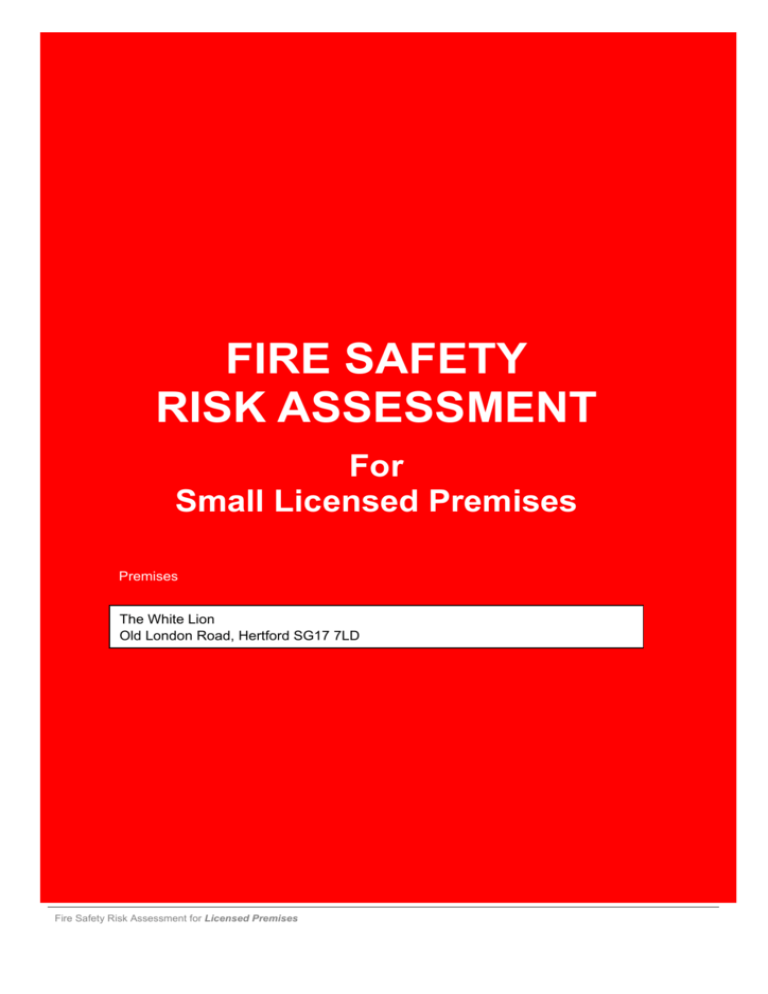
FIRE SAFETY RISK ASSESSMENT For Small Licensed Premises Premises The White Lion Old London Road, Hertford SG17 7LD Fire Safety Risk Assessment for Licensed Premises Introduction Regulatory Reform Order The Regulatory Reform (Fire Safety) Order 2005 (FSO) came into effect on 1 October 2006 and requires that a fire risk assessment is carried out in all relevant premises to determine what fire safety measures are necessary. The Responsible Person* in most cases the Premises Licence Holder/Designated Premises Supervisor for the premises has additional responsibilities relating to fire safety under Articles 8 to 23 of the FSO. Details of which can be found through the following link: http://www.opsi.gov.uk/si/si2005/20051541.htm#8 *"Responsible Person" means; (a) in relation to a workplace, the employer, if the workplace is to any extent under his control; (b) in relation to any premises not falling within paragraph (a)— (i) the person who has control of the premises (as occupier or otherwise) in connection with the carrying on by him of a trade, business or other undertaking (for profit or not); or (ii) the owner, where the person in control of the premises does not have control in connection with the carrying on by that person of a trade, business or other undertaking. Fire Risk Assessment This form is intended to assist small businesses in carrying out the fire risk assessment. It is suitable for use in small buildings, with a simple internal layout, e.g. small offices, shops or industrial units. In buildings with complicated escape arrangements, large numbers of people or high fire risk processes a more comprehensive fire risk assessment may be necessary. Note: It is recommended that this risk assessment form is completed in conjunction with the relevant Communities and Local Government guidance publication for ‘Small and Medium Places of Assembly’ premises use. These can be found through the following link: http://www.communities.gov.uk/fire/firesafety/firesafetylaw/ The enclosed information follows a simple 5 step guide to completing a suitable assessment. The fire risk assessment does not need to be complicated, it should be a common sense review to identify the hazards (what could start a fire and what could burn), followed by consideration of the possible effects of a fire on people using the building. The important thing is that the fire risk assessment is systematic to ensure that every part of the premises is assessed. Every room, space or area, especially those not often used, should be included. If you identify any significant risks you should consider if they can be reduced: first by removing the hazards and secondly by providing fire protection measures (e.g. automatic fire detection). These points should be addressed within the ‘What needs to be done to make each situation safe?’ section. If your business is located within a larger building and if a fire in your business could affect your neighbours, you should share the findings of your fire risk assessment with your neighbours. Your fire risk assessment must be kept up to date. It is important to update the assessment if anything is changed that might affect the risk (e.g. new ignition sources or use of flammable liquids etc.). If you identify that either the likelihood of a fire or the risk to people is not LOW you may want to consider seeking professional assistance. Fire Safety Risk Assessment for Small Premises 2 The 5 Steps to Fire Risk Assessment Fire Safety Risk Assessment for Small Premises 3 FIRE RISK ASSESSMENT 1. PREMISES PARTICULARS Premises Name: White Lion PH Use of Premises: Address: Public House Old London Rd Hertford SG17 4LD Tel No: 01992 507507 Responsible person for Occupiers part of the premises: Mr Jack Jones Landlord Date of Risk Assessment Date of Review: 1 March 2009 1 March 2010 Name and relevant details of the person who carried out the Fire Risk Assessment Mr John Smith Fire Risk Assessment Management Enterprises 101 Nowhere St, Leeds Hertfordshire Fire and Rescue Service recommends that if a third party is used to carry out the risk assessment that the Responsible Person is fully involved in the process 2. GENERAL STATEMENT OF POLICY In line with the Governments Licensing Objective – Public Safety: It is the policy of the White Lion PH to protect all persons including employees, customers, contractors and members of the public from potential injury and damage to their health which might arise from fire. We will provide and maintain safe and healthy working conditions, equipment and system of work for all employees, and to provide such information, training and supervision as they need for this purpose. We will give a high level of commitment to fire safety and will comply with all statutory requirements. Signed: J Jones Print Name: J Jones Risk Level: Following this assessment the level of risk is now deemed to be: (Acceptable/Unacceptable, measures required) further Date: 1 March 2009 Acceptable control Fire Safety Risk Assessment for Small Premises 4 3. MANAGEMENT SYSTEMS The Fire Safety Risk Assessment is contained within the Fire Safety file and is kept in the Landlords office, an additional copy is kept by Fire Risk Assessment Management Enterprises. The plan confirms that a fire risk assessment will be completed to ensure adequate fire safety and will be reviewed as necessary. The fire risk assessment will follow the five step approach detailed in the HM Government fire safety risk assessment guide. The significant findings will be recorded. Any deficiencies identified by the fire risk assessment process will be prioritised and rectified accordingly. The Landlord will have overall responsibility for fire safety matters which include; • • • • Fire risk assessment and all matters appertaining to it. Deciding the fire safety protective and preventative measures Ensuring they are implemented and communicated to other employees Ensuring co-ordination between other responsible persons Fire Safety will be an agenda item for the monthly Staff Meeting. The Landlord will be responsible for monitoring the effectiveness of the fire risk assessment process and its implementation. Maintenance of the safety measures of this risk assessment If any of the safety measures contained within this risk assessment are compromised an immediate risk assessment will be carried out to establish what control measures are required to allow continuation of business. Fire Safety Risk Assessment for Small Premises 5 4. GENERAL DESCRIPTION OF PREMISES Description: The building comprises of a two storey Public house constructed in 1958, using traditional brick built construction methods. The first floor comprises of residential accommodation for the Landlord and his family only The premises are considered to be of low risk as in the event of fire and there is little chance of anyone being placed at risk due to the fire safety measures in place. The building has one internal stairway which is protected by fire resisting walls, partitions and a self closing fire door, providing a minimum of half hour fire resistance. Occupancy: Times the Premises are in use: The Total Number of Persons Employed within the Premises at any one time: The Total Number of persons who may resort to the premises at any one time: 5. Size: 10.00am. to 01.00am 5 Building footprint (Metres x Metres): 100 Number of Stairs: 30 x 25m Number of Floors: 2 1 Internal FIRE SAFETY SYSTEMS WITHIN THE PREMISES Fire Warning System: (i.e. automatic fire detection, break-glass system to BS 5839, other) Emergency Lighting (i.e. maintained/nonmaintained, 1hr/3hr duration to BS 5266) Other: (i.e. Sprinkler System to LPC rules BS 5306) Fire fighting equipment Fire extinguishers, hose reels and fire blankets Fire Resisting construction Identify what fire resisting construction is required to secure the means of escape Fire resisting doors must be fitted with self closing devices or kept locked shut, doors must close fully on their stops. Fire Exits Identify what fire exits are required Electric fire alarm complying with BS 5839. Smoke detectors have been provided in a number of areas as indicated on the plan Non-maintained and maintained to 1 hour complying with BS 5266. None As shown on the plan drawing all equipment will be maintained by Acme Fire Equipment Ltd. As shown on the plan drawing any works undertaken will maintain the integrity of the fire resistance. All staff receive training and instructions to ensure this happens As shown on the plan drawing all exits will be maintained available when the building is occupied. Fire Safety Risk Assessment for Small Premises 6 PLAN DRAWING Complete a simple line drawing of the premises and identify your fire safety provisions – including escape routes, extinguishers, emergency lighting and fire alarm. X O Identifying Ignition and Fuel Sources Noughts & Crosses - As an aid to identifying the hazards within your premises it’s possible to use a system of noughts and crosses, using a X to mark ignition sources and a O for fuel sources. Fire Safety Risk Assessment for Small Premises 7 Step 1 ~ Identify fire hazards Sources of ignition Naked flames Heaters Location Kitchen Are existing control measures suitable? Existing control measure Staff are told to remain in the kitchen when food is being cooked on the gas hob Saloon Central heating Outside Patio heaters kept away from combustible materials All electrical equipment is PAT tested and only existing sockets are used. YES √ YES Electrical equipment e.g. overloaded sockets etc. Cooking facilities Lighting equipment Arson Office Bar Saloon Kitchen Kitchen All Bin Store Smoking materials Other sources Smoking Area NO NO √ YES NO √ Staff are told to remain in the kitchen when food is cooked on the gas hob YES All lighting is checked as part of the annual maintenance check YES Beer store kept locked Rubbish bin is against the rear wall YES Smoking Area situated away from the building enclosed ashtrays provided YES NO √ NO √ NO √ NO √ None YES If you have answered NO to any question above complete the details below What needs to be done to make each situation safe? Action required by? NO Date due Signed March 09 J Jones April 09 J Jones March 09 J Jones completed 9 9 9 Contract for extractor cleaning on a six monthly basis Jack Jones All staff receive fire safety training annually Jack Jones Reposition the rubbish bin away from the building and lock in place Jack Jones March 09 April 09 March 09 9 Fire Safety Risk Assessment for Small Premises 8 Step 1 ~ Identify fire hazards (continued) Sources of fuel & oxygen Wood/paper/cardboard etc Location Office Are existing control measures suitable? Existing control measure Paper is stored on shelving with no sources of ignition nearby. YES NO √ Plastics/rubber/foam (including packaging) None YES NO √ Electrical equipment e.g. overloaded sockets etc. All All electrical equipment PAT tested annually YES NO √ Furniture and fixings e.g. curtains All All soft furnishing are fire retardant YES NO √ Flammable gases/liquids e.g. oils/solvents etc Textiles Kitchen Cooking oil is stored in metal containers and kept away from ignition sources YES NO √ None YES NO √ Display materials Bar Saloon Menus and posters are kept away from heat sources YES NO √ Waste materials All Regular removal of waste material YES NO √ Additional oxygen supplies e.g. air conditioning units None YES NO √ If you have answered NO to any question above complete the details below What needs to be done to make each situation safe? Action required by? Date due Signed completed 9 Reposition the rubbish bin away from the building and lock in place Jack Jones March 09 J Jones March 09 9 9 Fire Safety Risk Assessment for Small Premises 9 Step 2 ~ Identifying people at risk Are existing control measures suitable? Consider who might be at risk? – e.g. staff, visitors, guests, customers etc. Why are they at risk? Staff working alone Location Bar Kitchen Control measure None Are existing control measures suitable? YES NO √ People with disabilities (including mobility, hearing, vision impairment) Saloon All exits have ramps YES NO √ Unfamiliar with the building Saloon Clear exit signage and fire alarm provided YES NO √ Contractors All All contractors are briefed prior to starting work YES NO √ Other YES NO √ If you have answered NO to any question above complete the details below What needs to be done to make each situation safe? Action required by? Date due Signed completed 9 A Contractor book to be established which will be signed and dated by them and risks will be pointed out to them prior to work commencing. Jack Jones March 09 J Jones March 09 9 9 9 9 Fire Safety Risk Assessment for Small Premises 10 Step 3 ~ Evaluate, remove, reduce and protect from risk Can hazards and risks be removed or reduced? The following examples can greatly aid the protection of people and property – 9 Separate ignition sources from combustibles 9 Improve security 9 Remove or improve storage of highly flammable materials 9 Replace temporary heaters with permanent fixed ones 9 Regularly remove refuse and packing materials 9 Provide automatic fire detection 9 Provide emergency escape lighting (in some circumstances provision of a torch may be suitable) 9 Test and maintain all fire safety equipment (i.e. fire alarm, emergency lighting and fire extinguishers) 9 Arrange electrical testing of appliances Evaluate fire safety arrangements Are ignition sources controlled to minimise the likelihood of fire? YES√ NO Are combustible materials kept away from ignition sources? YES NO√ Would a fire be discovered quickly? YES√ NO Will everybody be warned of the fire immediately? YES√ NO Is escape available in more than one direction? YES√ NO Can everyone escape without assistance? YES√ NO Are exits easily identified? YES√ NO Are escape routes free from obstruction? YES√ NO Are doors to outside easy to open? YES√ NO Is the alarm system tested and maintained in accordance with relevant British Standard Is the Emergency Lighting system tested and maintained in accordance with relevant British Standard Are fire extinguishers serviced in accordance with relevant British Standard YES√ NO YES√ NO YES√ NO If you have answered NO to any question above complete the details below What needs to be done to make each situation safe? Action required by? Date due Signed completed 9 Cooking oils are used in the kitchen, all staff are trained in correct use and what to do in case of a fire Jack Jones March 09 J Jones March 09 9 9 9 Fire Safety Risk Assessment for Small Premises 11 Step 4 ~ Record, Plan, Inform, Instruct and Train You must record your fire safety arrangements – this includes: Have you made an emergency plan and does it include the points below? NO YES√ Your emergency plan should include How will people be warned if there is a fire (this may range from a simple rotary gong or air horn fixed behind the counter to an electrical fire alarm system): Fire Alarm What should staff do if they discover a fire: Staff should raise the alarm by activating a break glass call point How should the evacuation of the premises be carried out: Staff will tell customers to leave Where should people assemble and how to check premises have been evacuated: Assembly point is in the marked area at the end of the front car park, Duties and identity of responsible staff if there is a fire: Landlord or duty manager will call the fire brigade Have you provided instruction and training to staff Has instruction and training been provided to all staff on what to do in case of fire? YES Are there records of fire drills, instruction and training? YES NO √ NO √ If you have answered NO to any question above complete the details below What needs to be done to make each situation safe? Action required by? Date due Signed completed 9 All staff will receive annual training, all new staff will receive training as part of their induction Jack Jones March 09 J Jones March 09 9 9 9 9 Fire Safety Risk Assessment for Small Premises 12 Step 5 ~ Review Your risk assessment must be kept up to date Date of next review It is recommended that you review your risk assessment every 12 months OR if you make changes to the layout of your premises, significantly increase the amount of combustible materials stored or displayed, change your opening hours (e.g. to include night time opening etc) you should review your fire risk assessment. 01/03/2010 For further information visit the website – www.firesafetyguides.communities.gov.uk or contact the Fire Protection Department of Hertfordshire Fire & Rescue Service – 01992 507507 A copy of this form can be found on – http://connect.hertscc.gov.uk Fire Safety Risk Assessment for Small Premises 13


